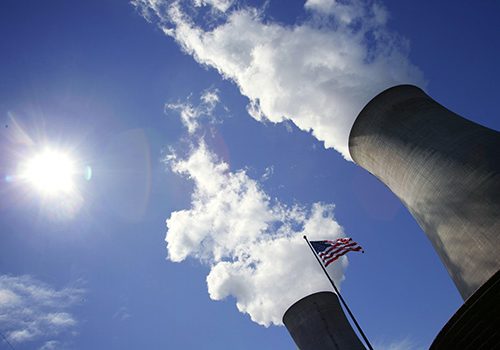The value of the US nuclear power complex to US national security
Table of contents
- Introduction
- The US civilian nuclear power complex and national security framework
- Estimation techniques, assumptions, and data
- Areas of analysis
- Conclusion and recommendations
I. Introduction
In this analysis, the Atlantic Council has set out to estimate the value that the civilian nuclear power sector contributes to the United States’ national security apparatus. Based on a series of inputs, this analysis and conservative estimation found that the nuclear power complex contributes an equivalent of more than $42.4 billion to US national security, as broadly defined. In other words, the lack of a civilian nuclear sector would present an immediate and significant economic shock (and impact on the labor force)—which, in turn, would have immediate and longer-term budgetary implications for the US government.
The definition of national security can be viewed narrowly or more broadly, in terms of both the scope of the institutional assets and providers of national security services and the types of functions or services they undertake. This analysis includes both nuclear utilities and nuclear generators, as well as US military and defense facilities, as providing critical national security functions. The utilities and generators provide secure and reliable electricity, accounting for 19.3 percent of total US electricity generation in 2018, and they contribute significantly to the diversified energy-generation mix that the United States enjoys.
There are three main reasons for public support of the civilian nuclear industry for national security purposes, which are identified in the analysis that follows. The reasons are
- the civilian nuclear industry generates a vast investment in human capital, which is a necessary condition for all applications of nuclear energy in the national security apparatus;
- the civilian nuclear industry and its associated supply chain provide critical risk mitigation and procurement safety to the national security apparatus; and
- the civilian nuclear industry’s value to national security priorities related to climate change.
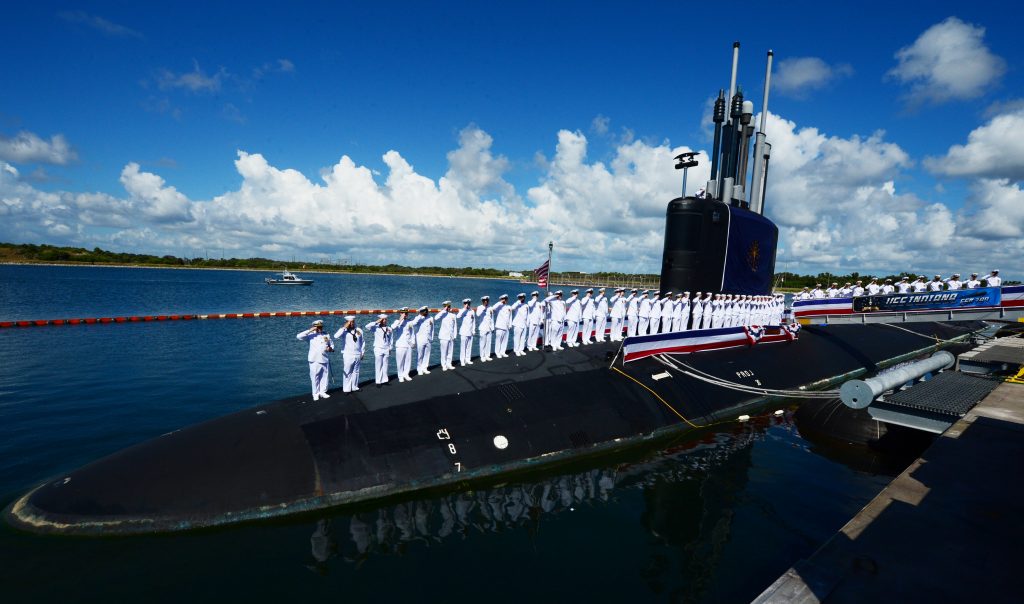
The Atlantic Council Task Force on US Nuclear Energy Leadership recently concluded that nuclear power is an essential contributor to national security. Nuclear energy provides critical economic, energy security, defense, foreign policy, scientific, technological, and environmental benefits. Although the United States has the largest civilian nuclear power industry and nuclear-powered navy in the world, it faces significant challenges to its leadership position on the civilian side, and it stands at a major juncture in its nuclear energy policy and industrial development. The research that follows builds on the conclusion of the task force’s report to quantify certain economic aspects of the issue.
Civilian nuclear power and the associated supply chain are interwoven with key US national security priorities, specifically US leadership in global nuclear nonproliferation norms, the support of the nuclear navy, and the nation’s nuclear deterrent. The connectivity of the civilian and military nuclear value chain—including shared equipment, services, and human capital—has created a mutually reinforcing feedback loop, wherein a robust civilian nuclear industry supports the nuclear elements of the national security establishment, while underwriting the strategic value of civilian nuclear power to the United States and encouraging growth over the long term.
II. The US civilian nuclear power complex and national security framework
In its recent report, the Atlantic Council’s Nuclear Task Force notes that the “risks and strains facing the US nuclear power sector have significant national security and foreign policy ramifications for the United States.” In terms of nuclear technology innovation, export capacity, and geopolitics, a vibrant civilian nuclear energy sector is a critically important national security asset. The anticipated closure of nuclear generators would adversely affect the nuclear supply chain and US human resources capabilities—mainly knowledge and expertise in civilian nuclear power—as well as services to the US military. Only two civilian reactors are currently under construction in the United States, while most new reactors are being built in China, Russia, India, and other Asian and Middle Eastern countries by non-US companies. There is also intense international competition to build the next generation of reactors, including small modular reactors (SMRs) and advanced non-light water reactors, which could find substantial markets in developing countries as well as in the United States.
The US nuclear power complex is large, and it involves both civilian and military organizations. At the core of the complex are the nuclear power generators and the US military commands and facilities. This study identifies three main areas of analysis and estimation: human capital in the workforce of the national laboratories, universities, and the nuclear navy; the replacement value of nuclear generation and its associated supply chain; and the value to the national security priority of climate change mitigation provided by the nuclear industry. In each of these areas, there is crossover between civilian and military expertise, personnel, and materiel related to nuclear energy. This study estimates the dollar value that the US military would need to spend in order to replace the (partial) loss of the civilian nuclear sector.
III. Estimation techniques, assumptions, and data
The analysis that follows includes an estimate of the value of the US nuclear power industry to the national security apparatus broadly defined. While there are important areas of overlap, this is a different exercise from estimating the impact of the industry and its supply chains on the overall economy. The latter analysis does give valuable boundary conditions for the analysis and estimations that follow. For example, in a frequently cited analysis, the Brattle Group estimates that the nuclear industry accounts for approximately 475,000 jobs and contributes $60 billion to US gross domestic product (GDP) annually. That same analysis includes the sizeable contribution to federal and state taxes (approximately $10 billion and $2.2 billion, respectively), which is excluded from the analysis that follows. Part of the excluded value of the industry also comprises its contribution to the trade balance by exporting nuclear fuel, technology, and services. The US Census Bureau statistics for 2017 show worldwide exports of nuclear fuel materials totaling $916 million. Exports of nuclear technology were $949 million.
This analysis is additionally sensitive to a number of important assumptions, exclusions, and limitations, which are introduced here and will be referenced where appropriate.
- “Snapshot” measure: the analysis and resulting estimates are conservative in the sense that they are focused on point-in-time estimates, based on the most recent data available, to provide a snapshot measure of economic impact. Based on assumptions around economic growth, industry capacity, and other factors, future research may assess the economic impact of the industry in future years, to provide discounted aggregates over different time horizons.
- Quantifiable impact: the analysis focuses on quantifiable, “physical,” economic impact. It has excluded, for example, considerations of the geostrategic value to the United States of being the global leader in nuclear technology. Other such areas include, for example, the importance of plutonium to future deep-space exploration and the importance of US leadership in developing a new generation of small modular and advanced reactors.
- This analysis acknowledges that the supply chain for the civilian nuclear industry includes many intermediate goods and products that have applications outside of the civilian or military nuclear industry. This estimation is an effort at quantifying the benefits solely to the national security apparatus.
- Additionally, there are forms of existing bespoke support to the industry. In many cases, such as loan guarantees or standby insurance provided by the federal government, it is not practical to discern how these instruments benefit the industry more than other industries, and this analysis was conducted without consideration of these support instruments.
The human capital dimension of this analysis is based on budgetary allocations that “price” the contribution of nuclear engineering and related fields, as well as an analysis of average wages for nuclear and other engineers compared to the national average. The value of nuclear generation and the related supply chain is bounded by the results of prior inter-industry analysis estimating the impact of the supply chain on the entire economy, and further informed by replacement value at constant reliability. Estimates of nuclear energy’s environmental benefits to the national security apparatus build on prior research.
In summary, using conservative assumptions, this analysis found an overall estimated value to the national security apparatus of approximately $42.4 billion, divided between human capital ($26.1 billion), nuclear baseload and the supply chain ($2.9 billion), and environmental benefits ($13.4 billion).

IV. Areas of analysis
Human capital
The civilian nuclear industry generates a vast investment in human capital that is a necessary condition for all applications of nuclear energy in the national security apparatus. The following analysis considers the staff in the nuclear supply chain at private companies, research universities, and the National Nuclear Security Administration (NNSA), among others. At different levels of specialization, the employees command wage differentials in the labor market that can serve as a useful quantitative indicator of the investment that would be needed in the case of a significant reduction or disappearance of the civilian nuclear industry. As shown in the above table, this element constitutes the largest component of estimated total costs and would certainly be difficult to reconstitute if lost.
US Department of Energy (DOE) national laboratories and research and development (R&D)
The DOE national laboratories are often referred to as “national treasures,” and they have extensive equipment and human scientific and technological expertise. They support both civilian and military energy programs, both nuclear and non-nuclear. Congress appropriated $37 billion in fiscal year 2019 (FY19) for the DOE laboratory system. The laboratories manage the implementation of most of the DOE nuclear energy programs, which in FY19 were funded at $1.326 billion, with Congress increasing the levels from the Trump Administration’s request. The Idaho National Laboratory is one of the leading nuclear labs, and received $1.6 billion in FY19, including about $318 million for management of the DOE Nuclear Energy Office programs. Another laboratory at Oak Ridge has 4,400 research and mission support staff, including 1,100 staff scientists and engineers. It has 3,200 users and visiting researchers annually, and in 2018 had program expenditures of $1.6 billion. Of course, not all these resources are devoted to nuclear projects, but this gives an indication of the size of one of the major national labs. In FY18 and FY19, the nine national laboratories with major nuclear energy programs received a total budget of about $10 billion.
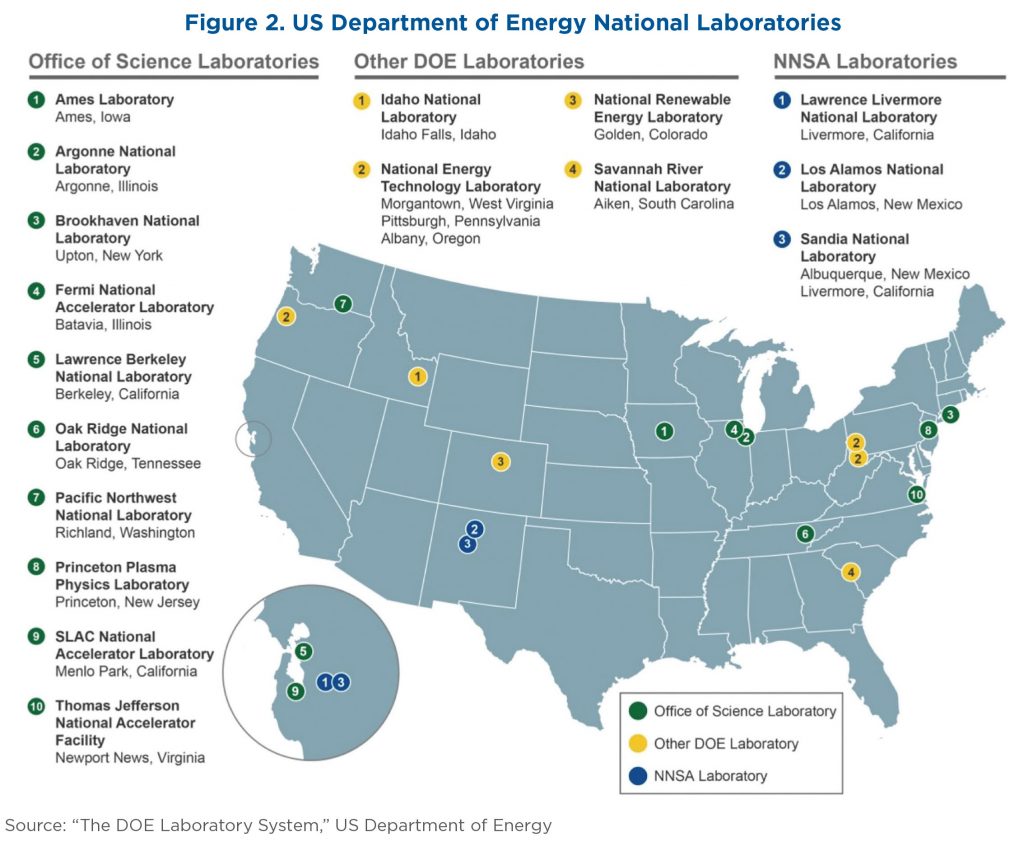
Education, universities, and human capital
Universities in the United States house leading centers of nuclear engineering and research, and they work closely with the DOE national laboratories and private companies on training and R&D. US companies are making extensive use of these capabilities in their efforts to develop advanced nuclear reactors, as well as to apply innovative technologies to improve the efficiency and operation of existing reactors. Due to technological advancement and improved management, the operating costs of US reactors have dropped 25 percent since 2012, to the lowest level since 2004. On the research side, TerraPower, a US company developing an advanced molten-salt reactor, indicated at the 2019 Nuclear Energy Institute (NEI) Nuclear Summit that it has been working with twelve universities and eight national laboratories in its development efforts. The DOE Gateway for Accelerated Innovation, managed by Idaho National Laboratory, is actively working with US universities on various research projects. A directory under the Gateway for Accelerated Innovation in Nuclear (GAIN) project samples the nuclear research and other related activities undertaken at nine universities and colleges.
In this section, estimates are conservatively based on the most specialized sector of the labor market supporting the civilian and military nuclear industries in the United States—US university graduates in nuclear engineering, at both the undergraduate and graduate levels. Data on enrollment compiled by the Oak Ridge Institute for Science and Education (ORISE) since the 1960s provide the basis for the below estimates. The enrollment data present a comprehensive reflection of the state of play in the US educational system and provide a good proxy for the health of the labor market for nuclear engineers at different levels of educational attainment.
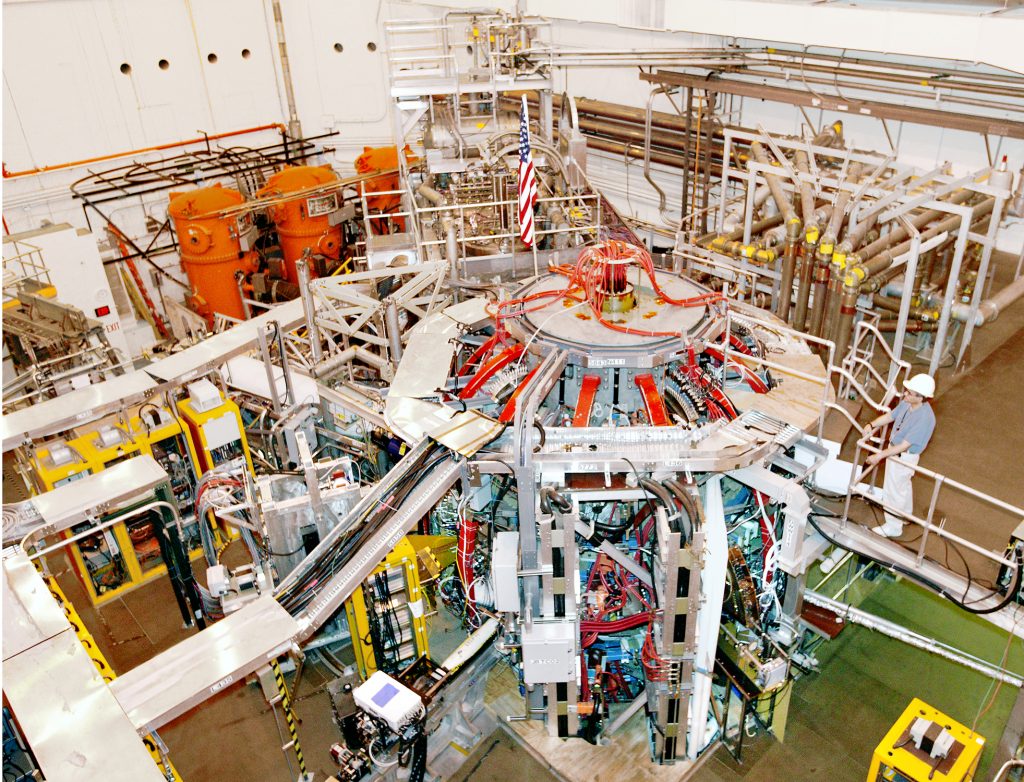
The latest survey, published in April 2019, discusses the findings of the 2018 survey and, in general, describes healthy enrollment trends relative to historical norms. According to the survey, thirty-five nuclear engineering academic programs awarded 623 bachelor’s degrees, 260 master’s degrees, and 195 doctoral degrees in 2018.

As part of its studies, ORISE also tracks the post-graduation job market or further-study intent of graduates in the nuclear engineering field. As others have discussed, here the survey continues to show a long-term trend away from anticipated employment in the commercial nuclear industry and toward government and academic employment in nuclear-related fields. With the lack of civilian nuclear new builds, this is not unexpected. This trend could, of course, change with new technology demonstrations, e.g., the NuScale twelve-module, 720 megawatt (MW) SMR project with the Utah Association of Municipal Power Systems (UAMPS), and commercialization of advanced technologies over the next ten to fifteen years.
As the figures that follow indicate, nuclear engineers command a wage differential that is a reward for the acquisition of human capital by those with advanced degrees: the reward for the opportunity cost inherent to the pursuit of the degree, usually measured by the foregone earnings during the years spent in a degree program. Nuclear engineers also benefit from the general trend of the widening wage gap between highly skilled and lower-skilled labor. While the educational system in the United States has, in the past, responded relatively quickly to increased demand for nuclear engineers, the supply of nuclear engineers (and highly skilled workers in general) is still inelastic relative to the general labor market, pushing up wages faster in a time of higher demand.

Using data from the Bureau of Labor Statistics (BLS), the following analysis attempts to quantify the cost of procuring a labor force of the size, skill level, and depth as the one currently employed by the civilian nuclear industry.
While there are gaps in the data, the following stylized conclusions can be drawn from the data summarized in the table below.
- Nationally, engineers as a group earn almost double the average hourly wage ($46.27 versus $24.20).
- Nuclear engineers, in turn, earn an average hourly wage of $53.63 nationally ($52.47 if one excludes the two states without nuclear plants for which data are provided), significantly higher than engineers on average nationally and/or in states with nuclear plants ($46.74).
- This pattern holds for all but two states for which comprehensive data exist to facilitate comparisons—in Washington and Virginia, the average engineer earns a higher wage than the average nuclear engineer, presumably due to the demand for specialized engineers in aircraft manufacturing and national security-related fields in those economies.
- Data on nuclear engineer wages in states without plants are thin: the data for Idaho ($20.90 average hourly wage, $47.15 average hourly engineering wage, and $61.67 average hourly nuclear engineer wage) and New Mexico ($21.83, $54.81, and $65.53, respectively) are indicative of the presence of the Idaho National Laboratory and Los Alamos and Sandia facilities, respectively.
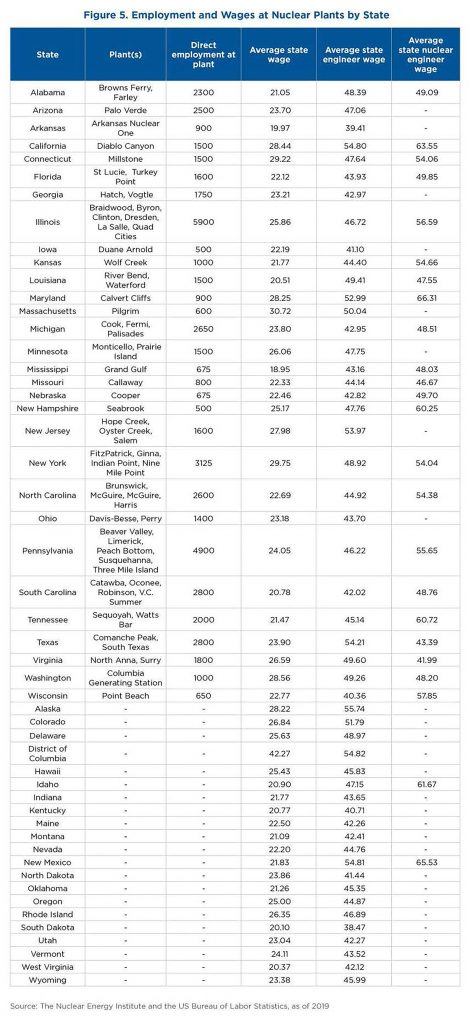
With these data in mind, it is possible to derive estimates of the annual national wage bill of the plants alone, based on assumptions of the employment mix and using existing estimates of secondary jobs created to get at some notion of a procurement cost for this labor force. The plants combine to employ close to 54,000 workers, with estimates of secondary jobs created going up to 475,000. Redeploying at average national wages, the labor of the plants and generators alone (assuming that the labor force is roughly balanced between workers making close to each of the three average wages) would incur a national bill of $4.64 billion ($905 million for workers making close to the national average, $1.73 billion for workers making close to the average engineering wage, and $2 billion for nuclear engineers). Taking the high-end estimate of 475,000 secondary jobs, and assuming the average salary of those is close to the national average, a full redeployment would run $23.9 billion. As such, it is reasonable to state that it would have a significant spillover economic impact and longer-term impact on the labor force, which, in turn, would have meaningful budgetary implications for the national government. As a conservative initial impact estimate over a short-term horizon, “purchasing” approximately half of this combined labor force would have a budgetary impact of $14.28 billion ($2.3 billion plant labor and $11.96 billion secondary).
The nuclear navy and the veteran workforce
The US nuclear power complex is especially important for the US Navy and its development, operation, and maintenance of about one hundred nuclear reactors in submarines and aircraft carriers. In the future, nuclear power sources may become integral to other services and commands, including the Army, Air Force, and new Space Command. The navy (and national security) currently benefits from externalities generated by the activities of the civilian industry and the associated research facilities that it would otherwise need to procure.
This analysis defines this complex as also including universities, national and independent research-and-development laboratories, fuel providers, and suppliers of equipment and technical services. These companies and institutions are active internationally. Nuclear fuel, technology, and services exports are also included in this national security equation. The role of these institutions in innovation and the R&D of new technologies is also of growing importance. The Trump Administration’s National Security Strategy and National Defense Strategy both highlight the need to maintain and enhance what is being called the “National Security Innovation Base” and the increasing interaction between civilian and military technologies.
A major component of the US nuclear power complex is the development, operation, and maintenance of nuclear reactors in the US Navy’s fleet. The nuclear fleet includes sixty-eight submarines; eleven aircraft carriers; and four research, development, and training platforms, and constitutes 45 percent of the navy’s major combatants. This program is funded under the National Nuclear Safety Administration of the Department of Energy and managed by the Office of Naval Reactors. Enacted funding in FY19 was $1.789 billion. The FY20 DOE Congressional Budget Request of $1.648 billion focused on three major programs: Columbia-class Reactor Systems Development, the Land-based S8G Prototype Refueling Overhaul, and the Spent Fuel Handling Recapitalization Project. This funding serves to support the Navy Nuclear Laboratory (NNL) and its Bettis and Knolls Atomic Power Laboratories, the Kenneth A. Kesselring Site, and the Naval Reactors Facility. In late 2018, NNL issued a large contract with ten-year options up to $30 billion to a subsidiary of Fluor Corporation for management and technical services. Bechtel, which was the previous NNL prime contractor, also has major contracts for component equipment and construction services with the navy, some under the navy’s shipbuilding and conversion funds for the Ford-class aircraft carriers. Another longtime supplier of reactors, fuels, and other services is BWXT, which has supplied reactors for the navy’s Ohio-, Virginia-, Seawolf-, and Los Angeles-class submarines, as well as the Nimitz- and Ford-class aircraft carriers.
There will be a major increase in demand for nuclear systems as the navy proceeds with its fleet-expansion programs. The “new naval force program” envisions a force increase to 355 ships, including twelve carriers, sixty-six attack submarines, and twelve ballistic-missile submarines, including replacement with Ford-class carriers and Columbia and Virginia ballistic and attack submarines.
Baseload and supply chain
Overview
The daily operation of the national security apparatus, as well as its execution on critical national security objectives, relies in important ways on the civilian nuclear system and its supporting supply chain. Among other things, the civilian nuclear industry and its supply chain provide critical risk mitigation in terms of diversity in energy supply, as well as procurement safety to the national security apparatus. This reliance of the military apparatus at the federal level can, by definition, only be partially captured by retail rates for electricity set at the state level.
As a useful outer estimate for the value of these benefits, consider the overall impact of the nuclear generation sector on the US economy. The aforementioned Brattle Group report, for example, estimates that the nuclear industry accounts for approximately 475,000 direct and secondary full-time jobs, in addition to contributing $10 billion in federal and $2.2 billion in state taxes each year, and undertaking $5 billion in new capital investments annually. The total annual addition to the US GDP from these activities is estimated at roughly $60 billion.
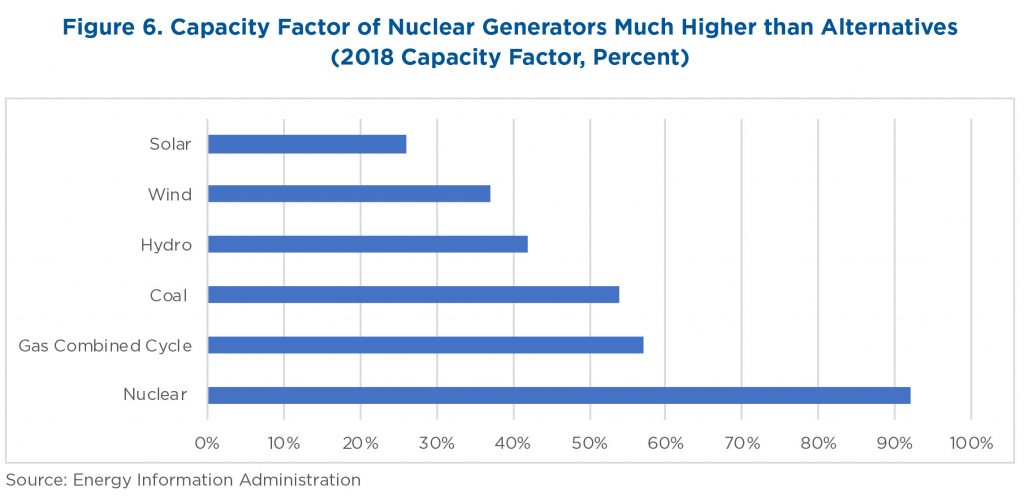
Baseload power for electricity system reliability
The value that US utilities and generators provide to the national security system in terms of dependable baseload power to US consumers is difficult to break out, although the Trump Administration has defended the importance of nuclear for maintaining a diverse and resilient electricity mix, especially related to the vulnerability of gas supplies during very cold weather. The issue of the role of nuclear energy in promoting system reliability and reliance has been a key topic of consideration by the Federal Energy Regulatory Commission (FERC) and with PJM and other independent system operators (ISOs). Some states are closing plants, while others have enacted subsidies (e.g., zero-emission credits) to maintain capacity. In 2018, nuclear plants operated at a capacity factor of 92.3 percent and provided 19.3 percent of the nation’s electricity. The high-capacity factor greatly exceeds that of other fossil and non-fossil sources in 2018: gas combined cycle (57 percent), coal (54 percent), conventional hydropower (42 percent), wind (37 percent), and solar photovoltaics (26 percent).
In addition, a mix of US and foreign companies supplies nuclear fuel to US nuclear power plants and the navy (only US fuel) for the nuclear-powered fleet. For civilian nuclear plants, nuclear fuel costs are about 20 percent of total generating costs, or about $5.98 per megawatt hour (MWh) in 2018. Total estimated fuel costs in 2018 for the 807 million MWh generated were therefore $4.8 billion out of total generation costs of $16 billion.
The specific fuel costs for the naval reactors is not broken out. A rough estimate is that nuclear fuel costs are 40–50 percent of the naval-reactor operating budget, or about $200–250 million per year.
Similarly, it is difficult to calculate the full benefits of the defense functions provided by the US nuclear-powered fleet. The budget for the Office of Naval Reactors—including technology development, operations, and maintenance—has been around $1.5 billion per year, and the FY20 budget request is $1.6 billion. For US bases, one source cites a figure of $4 billion for electric power purchases. The nuclear portion of the grid electricity provided to military facilities varies by state, but it is not estimated here.
Nuclear plants provide dependable, baseload power to US consumers, and contribute to the nation’s energy security, grid reliability, and resilience. In order to achieve a similarly dependable amount of baseload power using gas combined-cycle plants, one would have to use approximately 1.6 times the installed capacity.
To examine the cost of nuclear closure, this analysis assumes, consistent with earlier labor estimates, that half the current nuclear fleet is closed, and that 70 percent of the reduced generation is replaced by new gas combined cycles. The issue of substitution requirements is complicated by the substantial, continuing retirement of baseload coal plants in some regions. This analysis therefore assumes that generation from gas combined cycles would supply about 282 billion kilowatt hours (kWh) (compared with nuclear generation of 807.1 billion kWh in 2018). Applying the Energy Information Administration’s (EIA) projected average levelized cost of energy (LCOE) for new gas combined cycle plants introduced in 2023 of $42.8/MWh, the cost of supplying the 282 billion kWh is $12.1 billion. This calculation is very sensitive to gas fuel and replacement capital costs. It does not include the substantial costs of decommissioning nuclear plants, nor the growing issue of storage of spent fuel. Most plants have been licensed for sixty-year operation. If they are prematurely closed, major decommissioning costs will kick in. On the other side of the ledger, spent fuel is building up at the plant sites, and higher costs will likely be incurred to manage this problem in the future.
Using the relationship of national security spending to the overall federal budget as a rough proxy for the national security share of the benefit of stable, dependable baseload power. In 2019, this spending in the budget of the US Departments of Defense (DOD), Veterans Affairs, and Homeland Security is equivalent to around $900 billion, or around 24 percent of the total. Based on LCOE-based installed-capacity cost averages for reliability-equivalent options, the benefit of half of the baseload nuclear power currently provided to national security has an approximate value of $2.9 billion.

Supply chains in nuclear fuel, technology, and services
US nuclear generators are supported by a large complex of companies and institutions that stretches beyond just the commercial supply chain, which the Energy Futures Initiative (EFI) estimates at more than seven hundred companies in forty-four states, based on an inventory compiled by the American Nuclear Society (ANS). These companies provide a wide range of goods and services to the nuclear generation industry at different levels of specialization, and they are predominantly located in states with operating nuclear plants. Along with the ongoing decline in the number of nuclear reactors, there is an ongoing loss of domestic production capacity for critical components such as pressure vessels. These growing gaps in the domestic supply chain increase industry reliance on global supply chains.
Office of Naval Reactors officials have indicated that several hundred companies, which must meet stringent standards, are involved in supporting their program. There are about twenty-eight prime contractors that work for the Office of Naval Reactors in three major areas: power block (only one), pumps and flow equipment, and instrumentation and control.
While the United States imports more than 90 percent of its uranium, mainly from Canada and Australia, the uranium is converted in the United States, enriched to 3–5 percent U-235, fabricated into pellets, loaded into fuel rods, and combined into fuel assemblies for specific reactors. There is currently one low-level enrichment facility (Urenco’s gas-centrifuge uranium-enrichment facility near Eunice, New Mexico) and three fabrication plants (Global Nuclear Fuel Americas plant in Wilmington, North Carolina; Westinghouse Columbia Fuel Fabrication Facility in Columbia, South Carolina; and Framatome facility in Richland, Washington) in the United States. Utility and nuclear generator purchases of fuel were estimated to be about $4.8 billion in 2018 ($5.98 per MWh), which represented about 18.7 percent of total US nuclear generating costs. President Trump, to further a congressional inquiry into the national security implications of US dependence on imported uranium, signed a memorandum in July 2019 expressing concern about the situation and creating an interagency US Nuclear Fuel Working Group, co-chaired by the assistant to the president for national security affairs and the assistant to the president for economic policy, to examine the issue.
Environment
Finally, environmental and climate change threats have, for some time, been recognized by the DOD as of growing relevance to national security. The US nuclear utilities are central assets in US emission-mitigation efforts, currently providing the largest source of US carbon-free electricity at 55 percent. A full valuation of national security should estimate the costs of climate change and the externalities of fossil-fuel generation and its carbon emissions.
Early closures would increase carbon-dioxide (CO2) emissions by as much as 6 percent by 2035, based on a report by the Union of Concerned Scientists, depending on whether the plants are replaced by natural gas units. The NEI estimates that CO2 emissions avoided in 2018 were 528 million metric tons, representing about 10 percent of total estimated US energy-related CO2 emissions. After adding avoided sulfur-dioxide (SO2) and nitrogen-oxide (NOx) emissions, NEI calculates a social cost of $28.1 billion, or a little more than $50 per ton of CO2. If one uses a conservative $25-per-ton assumption, the benefits from nuclear amount to $13.2 billion.

V. Conclusions and recommendations
The United States has a large educational, R&D, and industrial-support system that underpins its civilian nuclear power sector, as well as its military nuclear enterprise. Closure of nuclear reactors erodes this system and impacts both current and future military operations, technologies, and the national security innovation base.
The reliability of the US electricity system is important to the national security apparatus, since US bases and facilities rely mostly on power from the civilian grid. Dependable baseload power from nuclear plants enhances this reliability. Closed nuclear plants would likely be replaced by gas combined cycles and renewable generation, which may be more expensive and/or reduce reliability.
Climate change has important implications for military facilities and their operations. The DOD has assessed the adaptation needs for bases and facilities in the United States, but no public estimate of these costs was found. The closure of nuclear plants will lead to increased CO2 emissions and contribute to DOD adaptation costs over time.
This report concludes that—based on conservative estimates of the value it provides due to human capital, dependability of the energy supply, vibrancy of the supply chain, and contributions to green power—the civilian nuclear energy industry contributes at least $42.4 billion annually to the pursuit of US national security priorities. In other words, an economic shock of at least that size, as well as almost-immediate federal budget implications, would result immediately in the case of a more rapid erosion of civilian nuclear capacity than the one currently underway. Therefore, this report recommends that the federal policy and budgetary implications of a continuing, and even more rapid, potential erosion of civilian nuclear capacity be seriously addressed. Since it abstracts from such other factors as the role and value of US international leadership and innovation capacity in this critical geostrategic field, it is likely that longer-term costs would be a multiple of the $42.4 billion estimate.
About the authors
The Atlantic Council extends a special thanks to ClearPath Foundation for its generous support, without which this report would not have been possible.
Related content
Image: The crew of the Virginia-class attack submarine USS Indiana (SSN 789) salute after bringing the ship to life during the boat’s commissioning ceremony in Port Canaveral, Florida, September 29, 2018 (photo by US Navy, Senior Chief Mass Communication Specialist Leah Stiles/Flickr).


